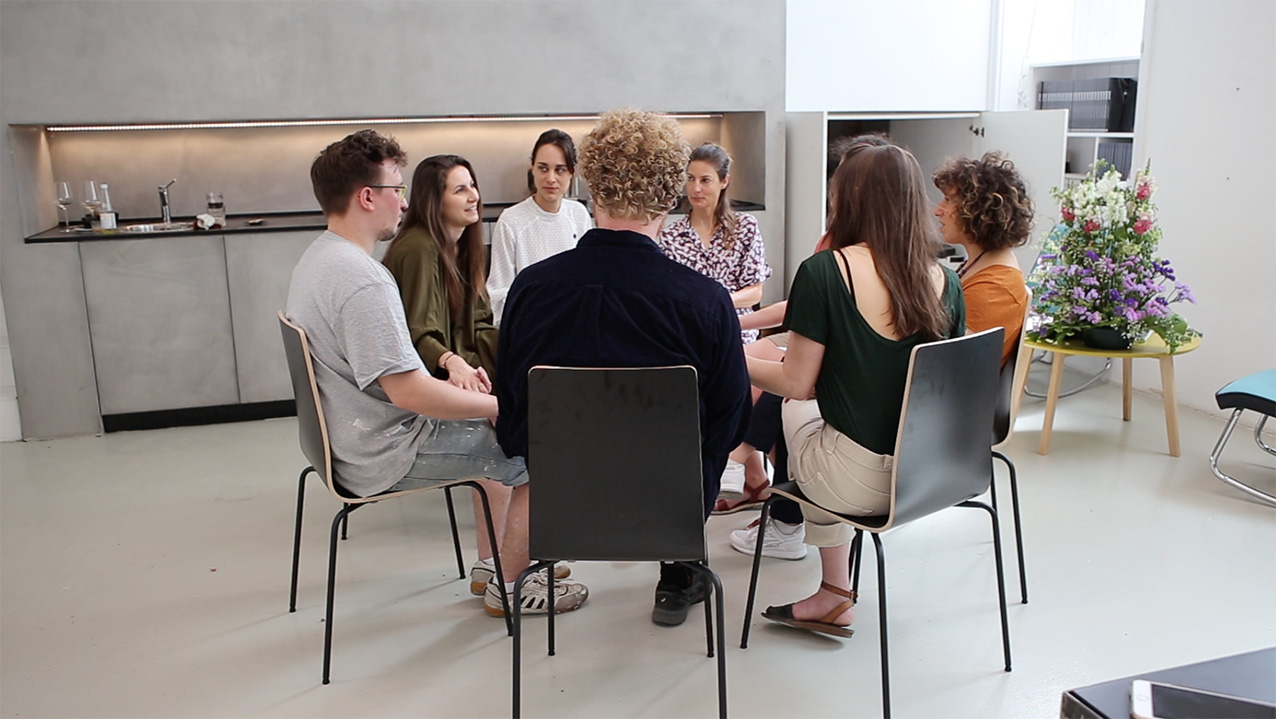Touching Art
Naama Ityel & Diana Sirianni
This workshop aims to disarticulate and reconfigure based on an idea of mutual solidarity and appreciation the way artists, curators, gallery owner, gallery staff, audience normally interact within the frame of an art exhibition in its different phases of preparation, installation, opening, gallery visit.
The workshop has two parts.
Part 1
The background of this workshop is that we (Naama Ityel and Diana Sirianni) were both invited to participate to a group exhibition at Lisa Kandlhofer Gallery, Vienna. Naama Ityel, from a physical and dance background, displayed a choreographed living sculpture and Diana Sirianni, from a visual background, a site-specific architectonical collage.
We spent about ten days in Vienna preparing our artworks. Normally this process is a relatively solitary process where the artist works alone or interact with assistant, curator and gallerist around the work and is often under stress because of expectations, shortage of time and resources, and conflicts that might rise. The other actors involved in the process of the show preparation also have often a challenging time: the curator needs to mediate, socialize, elaborate concepts, deliver a “product” by a certain time; the gallerist is nervous because they expose themselves socially and financially; the gallery staff and the assistants need to obey to orders all the time and receive everybody's frustration.
We believe that art and culture are instruments for social change meant to challenge oppressive structures. Our workshop turns around this question: is it possible to expand the values incorporated in the artworks to the layer of the art production and of the human interactions involved in it?
The workshop aims to interrupt the usual interactions and introduce new possibilities.
The three days before the exhibition opening, we organized a circle of sharing and emotional support, to cross hierarchy and go against isolation, asking questions like: what is new and good for you today? What is going well for you until now in the construction of the exhibition? What is challenging? What do you appreciate in the exhibition?
We introduced and facilitated a practice of mutual listening that enabled people to feel in a protected space and express their emotions and feel connected, understood and empowered by the others. We worked to turn an atmosphere of competition and loneliness into one of reciprocal appreciation and solidarity. In the background there is the belief that the creation of a community support offers the optimal conditions for the unfolding of the creative potential of the exhibition.
Part 2
This part completes the first part, expanding the practice to the public and focusing on the art reception.
This part is about the receiver. “Normal” art tours tell you something about the artworks and their history. You participate by listening to an informative and intellectual content that somebody else is giving to you. In this workshop we want to reverse this relationship shifting the attention from the artwork to the receiver and to the process of receiving. Which are the unspoken rules about the way you are supposed to receive art? And how do these conventions affect you on an emotional, physical level? How does this influence the way we understand art?
During the meeting we read and commented some theory from Silvia Federici´s essay Caliban and the Witch, raised awareness about our body and about how it acts in the gallery situation. Strength, trust and appreciation in your own judgement, connection to yourself and others, solidarity are values we conveyed through this experience. Art not only happens through the action of the artist, rather it is a mutual creation where the receiver plays a fundamental role. Art takes place only in the moment that it resonates in somebody else’s mind. It is a communication between different minds. In order to unfold all the potential art owns, we need to work on both sides: the artist’s and the audience’s. The audience plays an essential role, even if society tends to invalidate it and organizes art in way that makes the receivers feel as they were an optional.
Lisa Kandlhofer Gallery, Vienna, within the exhibition You followed me to the sun, 2018
 Video Still: Diana Sirianni
Video Still: Diana Sirianni